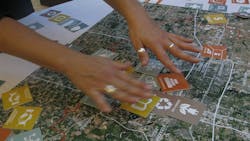People love where they live. They have an inherent desire to see the places they call home thrive. Too often, however, members of a community are put into a reactive position, asked for their input only when a major project is proposed. Meanwhile, opportunities for proactive civic engagement are few and far between, though some examples are beginning to emerge.
Last month in Waco, Texas, a group of students from fifth to ninth grade came up with several ways they could pitch in to make their community better. From animal rights to poverty to homelessness, they wanted to work together to help Waco meet its challenges.
In South Carolina, recently, residents of the Poe Mill neighborhood in Greenville gathered to paint a mural on a blank façade at the entrance of their community. They say it's a small part they can easily play in a wide-reaching neighborhood improvement initiative headed by the city.
These communities are not alone in their desire to get engaged. Citizens across the country demonstrate passion and commitment to local progress for city-led improvement projects. In its Soul of the Community report, the Knight Foundation found that "three main qualities attach people to a place: social offerings, openness, and aesthetics."
As such, people are deeply invested in making sure their communities have entertainment venues, physical beauty, and a welcoming atmosphere. Planners and civic leaders would be remiss to leave citizens out of the planning process; as cities undertake improvement projects, a main component in success lies in incorporating the input of vested local citizens, early and often.
Citizens Deliver State of the City
At the end of the day, local leaders, planners, and design professionals are also members of their communities. They have kids in school and they go to the park just like everybody else. They shop at the farmer's market and pay the water bill. They know the importance of keeping their constituents in mind when making decisions.
But they also know they have to go deeper than that: meaningful engagement with the right people will reveal solutions and ideas that otherwise would not come to surface.
In a May 2014 survey, we hoped to find some of those hidden sentiments as a way to better inform our civic projects in the future. The results, released in the State of the City Experience report, reveal some important design insights:
• The most common reason people venture to new parts of their cities is to try out a new restaurant. Recognizing the powerful draw of food and beverage establishments, we can activate new or revitalized neighborhoods by incentivizing restaurants – and today's hot mobile food scene.
• Of people's most memorable urban experiences, 65% happen in a community park or on a street. Transforming existing underutilized space into new parks and outdoor spaces takes design innovation and, often, engineering ingenuity, but these spaces ultimately provide unique and memorable experiences and enhance the value of our communities.
• A majority of people find historic architecture more interesting than newer buildings. Contemporary architects should be more intentional about designing buildings that leverage the characteristics of historic buildings. Learning from the past, they can do so by cultivating character, incorporating detail, keeping a human scale, and linking buildings to the public realm.
The Impact of Insights
To gain this kind of powerful input on the local level, community leaders and planners use a number of different methods to engage people. In several communities over the past few years, MindMixer and Sasaki have worked together to connect community members with the projects they care about, creating online engagement platforms that allow for proactive input from community members to inform future development.
Some of these communities include the following:
• Raleigh, N.C.
• Fort DuPont, Del.
• Fort Monroe, Va.
• University of Nebraska-Lincoln
• Des Moines, Iowa
MindMixer and Sasaki share an interest in making places the best they can be, with the help of the people who love them. We also share a passion for helping people love those places even more by involving them in the planning and design process from the beginning, giving them ownership of their surroundings, and creating advocates for these vitally important projects.
Over the next few weeks, keep an eye out on the Sasaki Ideas blog and on Mindmixer's Mix Blog as we collaborate to dig deeper into the amazing ways different communities have engaged their residents to tackle some of their most pressing challenges.
About the Authors
James Miner is head of Sasaki's planning and urban design practice and chair of the Executive Committee. Jessie Bauters is a Community Builder at MindMixer, where she contributes to marketing, social media, blog, and sales content creation. Miner and Bauters are passionate about finding new ways to engage diverse stakeholders in planning and design processes to give them ownership over the projects that impact their surroundings.
Read more posts at the Sasaki Ideas blog
About the Author
Sasaki
At Sasaki, we believe in the transformative power of place. Places transcend physical spaces, becoming the context and the content of our experience of life. For over 60 years, Sasaki has brought together the best of architecture, interior design, planning & urban design, space planning, landscape architecture, and civil engineering to shape the places in which we live. Out of our Boston, Denver, and Shanghai offices we are defining the contours of place and redefining what’s possible along the way. Visit our website and follow us on Facebook, LinkedIn, and Twitter.
